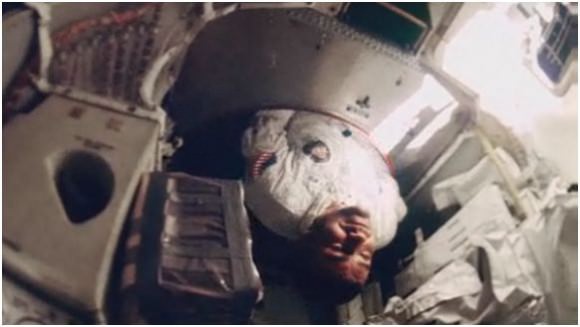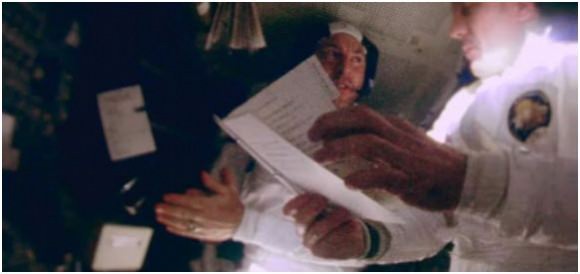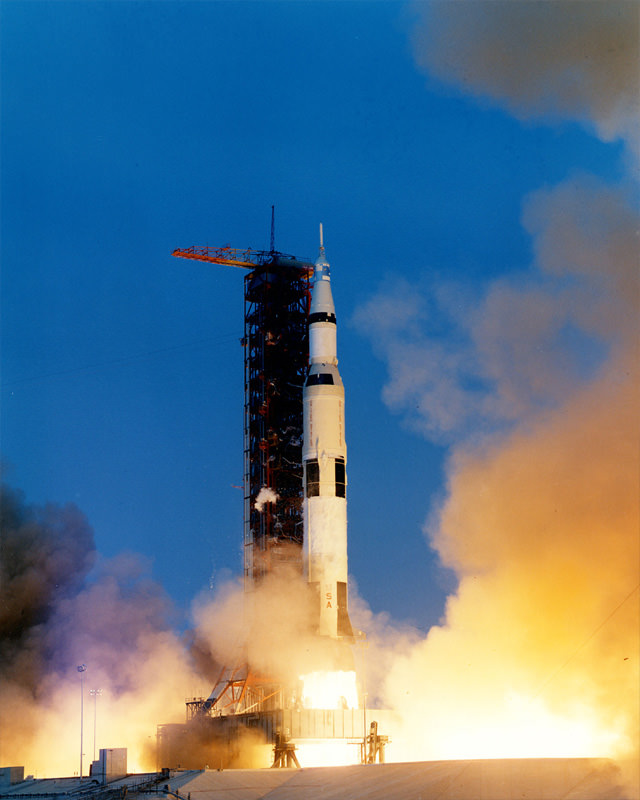[/caption]
Note: To celebrate the 40th anniversary of the Apollo 13 mission, for 13 days, Universe Today will feature “13 Things That Saved Apollo 13,” discussing different turning points of the mission with NASA engineer Jerry Woodfill.
When the oxygen tank exploded on the Apollo 13 Command Module, the astronauts on board and everyone in Mission Control had no idea what the problem was. In his book, “Lost Moon,” Apollo 13 commander Jim Lovell thought the “bang-whump-shudder” that shook the spacecraft could have been a rogue meteor hit on the lunar module, Aquarius. Quickly, he told Jack Swigert to “button up” or close the hatch between the Command Module Odyssey, and Aquarius, so that both spacecraft wouldn’t depressurize.
But the hatch wouldn’t close.
Apollo engineer Jerry Woodfill believes the balky hatch was one of the things that helped save the Apollo 13 crew. “They were trying to close off the only way they could save their lives,” he said.
In Mission Control and in the nearby Mission Evaluation Room, several engineers, including Woodfill, thought the only explanation for so many systems to go offline at once was an instrumentation problem. “Initially I thought there was something wrong with the alarm system or the instrumentation,” said Woodfill, who helped develop the alarm system for the Apollo spacecraft. “There was no way so many warning lights could illuminate at once. I was sure I would have some explaining to do about the system.”

At first, Lovell thought Fred Haise may have been playing a joke on the crew by actuating a relief valve that made a sort of popping noise – something he had done previously during the flight. But with the surprised look on Haise’s face, along with the noise and all the alarms going off, Lovell’s next thought was the hull had been compromised in Aquarius.
Like a submarine crew that closes hatches between compartments after being hit by a torpedo or depth charge, Lovell wanted to close the hatch into the Command Module so all the air didn’t rush out into the vacuum of space.
Swigert quickly tried three times to close the hatch, but couldn’t get it to lock down. Lovell tried twice, and again couldn’t get it to stay closed. But by that time, Lovell thought, if the hull had been compromised, both spacecraft surely would have already depressurized and no such thing was happening. So, the crew set the hatch aside and moved on to looking at the falling gauges on the oxygen tanks.
And shortly after that, Lovell looked out the window and saw a cloud of oxygen venting out into space.
Earlier in the flight, the Apollo 13 crew had opened the hatches between Odyssey and Aquarius, and actually was far ahead on their checklist of preparing to land on the Moon by turning on equipment in the lander.
Woodfill believes this was fortuitous, as was the hatch not closing, because saving time was of the essence in this situation.
“Some people say that doesn’t amount to much time,” Woodfill said, “but I say it did, because if they had closed and latched up the hatch, and then worked to find the real problem of what was wrong, then they would have to delay and quit working the problem to go remove the hatch, stow the hatch and go power up the lander.”
Why was time so important?
The fuel cells that created power for the Command Module were not working without the oxygen from the two tanks. “Tank 2, of course, was gone with the explosion,” said Woodfill,” and the plumbing on Tank 1 was severed, so the oxygen was bleeding off from that tank, as well. Without oxygen you can’t make the fuel cells work, and with both fuel cells gone they know they can’t land on the Moon. And then it became a question of whether they can live.”
But over in Aquarius, all the systems were working perfectly, and it didn’t take long for Mission Control and the crew to realize the lunar module could be used as a lifeboat.

However, all the guidance parameters which would help direct the ailing ship back to Earth were in Odyssey’s computers, and needed to be transferred over to Aquarius. Without power from the fuel cells, they needed to keep the Odyssey alive by using the reentry batteries as an emergency measure. These batteries were designed to be used during reentry when the crew returned to Earth, and were good for just a couple of hours during the time the crew would jettison the Service Module and reenter with only the tiny Command Module capsule.
“Those batteries are not ever supposed to be used until they got ready to reenter the Earth’s atmosphere,” said Woodfill. “If those batteries had been depleted, that would have been one of the worst things that could have happened. The crew worked as quickly as they could to transfer the guidance parameters, but any extra time or problem, and we could have been without those batteries. Those batteries were the only way the crew could have survived reentry. This is my take on it, but the time saved by not having to re-open the hatch helped those emergency batteries have just enough power in them so they could recharge them and reenter.”
It’s interesting when the hatch had to work correctly, when the lander was jettisoned for re-enty, it worked perfectly. But at the time of the explosion, it’s malfunctioning kept the pathway to survival into the LM open, saving time. Being able to get into the lunar lander quickly was what helped save the crew’s life.
Tommorow: Part 3: The measles
Additional articles from the “13 Things That Saved Apollo 13”
series:
Introduction
Part 3: Charlie Duke’s Measles
Part 4: Using the LM for Propulsion
Part 5: Unexplained Shutdown of the Saturn V Center Engine
Part 6: Navigating by Earth’s Terminator
Part 8: The Command Module Wasn’t Severed
Part 12: Lunar Orbit Rendezvous
Part 13: The Mission Operations Team
Also:
Your Questions about Apollo 13 Answered by Jerry Woodfill (Part 1)
More Reader Questions about Apollo 13 Answered by Jerry Woodfill (part 2)
Final Round of Apollo 13 Questions Answered by Jerry Woodfill (part 3)
Never Before Published Images of Apollo 13’s Recovery
Listen to an interview of Jerry Woodfill on the 365 Days of Astronomy podcast.


I wonder if they’ll get to the most important of the 13 reasons: Never have a mission name with the unlucky number 13 in it… XIII = mission fail and some bad rcoket joo-joo…
That and the black cat that scurried accross the broken mirror under the ladder near the launch gantry shortly before launch… I wonder how close to halloween was that launch? .. 😉
Holy moly!! Just out of curiosity I googled the launch date.. Here’s what I found:
Launch April 11 02:13:00 p.m. 00:00:00
LO2 tank anomaly April 13 10:07:53 p.m. 55:54:53
If there were a time to be superstitious it would be now methinks…
Very good, I’m like reading a fiction Omega novel, they’re really calm in solving the problems =)
Hi. Great Article. I think I have some hints regarding the measles. It’s shown in the film how Ken Mattingly use the Simulatoer to help his friends. Also they show him as CapCom but I do not think that Ken acted as CapCom in that flight. Please fix me If I am wrong.
Another fact about the CapCom Vance Brand. He was the last Apollo astronout flying to meet the Russion together with Deke Slayton, which was one of the first astronauts at the Mercury program and never flied to space due to medical problems. Deke got his chance on the last Apollo mission just to mee the old “enemies” the Russions.
Symbolic.
Why the hatch was open in the first place? Is the rule in space, always make actions when you have time although scheduled for later? How long the procedure takes normally (No rush)
One of the best articles! Congrats!
One question: is it clear now why the hatch did not work? I think it would be mission critical for such a system to fail… Was this failure related to the explosion?
Hmm… So many serendipitous occurrences! Could this be proof of time travelers assisting? Almost seems that way, that is, if you don’t believe in angels…
Do we now know why the hatch didn’t work? And why it was later able to be closed?